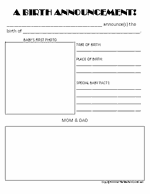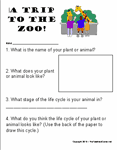 The Teacher's Corner
The Teacher's Corner
Life Science Lesson Plans, Activities and Projects
![]()
![]() This indicates resources located on The Teacher's Corner.
This indicates resources located on The Teacher's Corner.
![]() Baby Animal Birth Announcement Grades: Various
Baby Animal Birth Announcement Grades: Various
 Summary: This is a fun and creative way for students to share their knowledge about various baby animals.
Summary: This is a fun and creative way for students to share their knowledge about various baby animals.
Materials Needed: Baby Birth Announcement PDF
Procedure: Students can use textbooks, library materials, and/or online resources to complete the worksheet. This worksheet will allow them to share the following information: name of animal, location where animal lives, special physical features of the baby animal, a drawing of the baby animal, and a drawing of the animal’s parents.
Submitted by: Jennifer
![]() Mealworm Observation Science Project
Mealworm Observation Science Project
Mealworms can be an easy and fun way for students to learn about life cycles. There are a number of experiments that your students can conduct in order to better understand the mealworm.

Submitted by: Jennifer
![]() Zoo Research Packet
Zoo Research Packet
Help deepen your students’ learning during your next field trip to the zoo. The packet is designed to have students find an animal at the zoo for each of the seven continents. For each animal they record its name, draw a sketch of the animal, and write information regarding the animal’s habitat. Prior to leaving for the zoo, make a copy of the packet for each of your students. You will also want to review your expectations for the packet.
EXTENSIONS:
- Using the map, students can locate and color the region in which the animal can be found.
- If you choose to copy the packet single-sided, you can have students draw an illustration of the animal’s habitat. They could also include additional facts they learn about the animal.


Submitted by: Jennifer
![]() A Trip to the Zoo
A Trip to the Zoo
 Taking your students to the zoo is always a fun and exciting adventure. Keeping your students focused on the educational goals of the trip can be another story. Use the "A Trip to the Zoo" form to help your students not only stay focused on a specific plant or animal, but to also connect their classroom learning to their zoo experience
Taking your students to the zoo is always a fun and exciting adventure. Keeping your students focused on the educational goals of the trip can be another story. Use the "A Trip to the Zoo" form to help your students not only stay focused on a specific plant or animal, but to also connect their classroom learning to their zoo experience
Submitted by: Jennifer
![]() Dinosaur Drawings Grades: K-6th
Dinosaur Drawings Grades: K-6th
Objectives: Development of fine and gross motor skills and incorporating nature with art in order to have a better perspective and understanding.
Materials Needed: Sidewalk chalk, measuring tape (premeasured string for easier measuring)
Procedure: Use science or nature books to find out the
measurements of a variety of dinosaurs. Have the children use the
measuring tapes, string, and chalk to mark out the dimensions. The
best area for this activity is on the blacktop (playground).
Submitted by: Jennifer
![]() Bacterial Model Grades Middle School & Up
Bacterial Model Grades Middle School & Up
My model helps students learn each part of a bacterial cell and what that part's function is. Download the worksheet to walk your students through the process.
Submitted by: Jenny Keller - Cleveland, Texas
![]() Bird Unit Grades Any
Bird Unit Grades Any
I have collected some great ideas for you to get your bird study "off the ground".
![]() Digestion Simulation Grade 2
Digestion Simulation Grade 2
This fun and simple demonstration shows students how the stomach digests food. Have students work in groups of 2-3. Each group gets a quart size zip-lock bag (stomach), cracker and piece of banana (food), and a few drops of water (digestive juices). Seal the bag and take turns kneading the bag like your stomach does to your food. After a while the cracker and banana become a liquidy mixture. This gives kids a hand-on explanation of how solid food as they know it is not utilized by the body that way.
Submitted by: Charmoo123@email-removed
![]() Insect Unit
Insect Unit
Our complete Insects thematic unit.
![]() Mammals Unit
Mammals Unit
Our complete Mammals thematic unit.
![]() Penguins Unit
Penguins Unit
Our complete Penguin thematic unit.
![]() Plants Unit
Plants Unit
Our complete Plants thematic unit.
![]() Reptiles & Amphibians Unit
Reptiles & Amphibians Unit
Our complete Reptiles & Amphibians thematic unit.
![]() Respiratory System Unit
Respiratory System Unit
Our complete thematic unit.
 Back to the Science Lesson Plan Index
Back to the Science Lesson Plan Index
The Human Body Online
Find animations, graphics, and thousands of descriptive links.
KidsWings Grades 3-10
A web site to help you and your students get the most out of your owl pellet dissection.
Monterey Bay Aquarium's E-Quarium
A virtual aquarium! Be sure to check out the "Creature Feature". Find great information on you favorite marine species.
Operation RubyThroat: The Hummingbird Project
Everybody loves hummingbirds, and these tiny feathered dynamos can be used to help anyone learn about science, math, geography, culture, or virtually any academic discipline. Operation RubyThroat is an award-winning cross-disciplinary project in which participants in the U.S., Canada, Mexico, and Central America collaborate to study behavior and distribution of the Ruby-throated Hummingbird (Archilochus Colubris). This web-based project is open to all, but K-12 teachers and students especially are invited to participate. The Operation RubyThroat Web site--the most comprehensive one available about hummingbird natural history, banding, and research--is an outreach initiative of Hilton Pond Center for Piedmont Natural History near York, South Carolina, USA.
Eagle Cam
Follow up close and personal, the adventures of a pair of Bald Eagles at Berry College.
Texas State Aquarium
The emphasis of this site is the education of children about marine life. They have online activities and games designed to assist in teaching.
![]() EMAIL us your favorite life science resource.
EMAIL us your favorite life science resource.